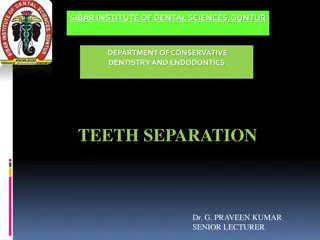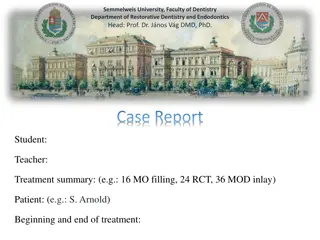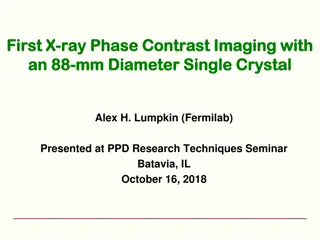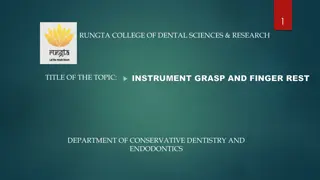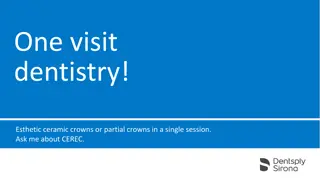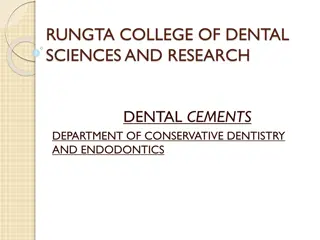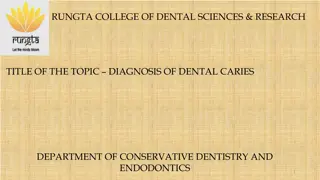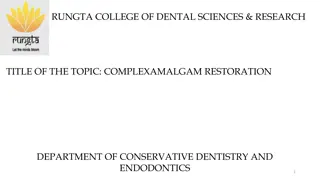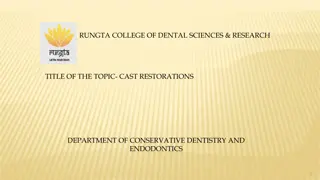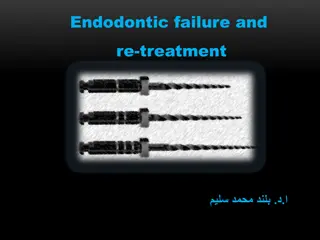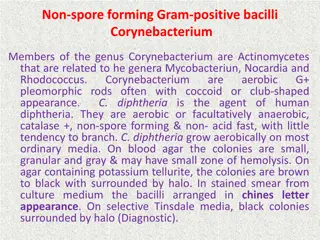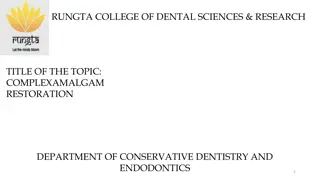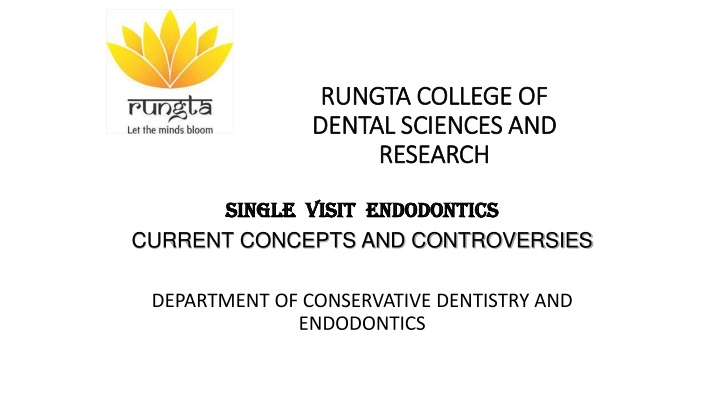
Single Visit Endodontics: Current Concepts and Techniques
"Explore the latest in single visit endodontics, including indications, techniques, advantages, and outcomes. Discover how this approach is gaining acceptance for efficient and effective root canal treatments."
Download Presentation

Please find below an Image/Link to download the presentation.
The content on the website is provided AS IS for your information and personal use only. It may not be sold, licensed, or shared on other websites without obtaining consent from the author. If you encounter any issues during the download, it is possible that the publisher has removed the file from their server.
You are allowed to download the files provided on this website for personal or commercial use, subject to the condition that they are used lawfully. All files are the property of their respective owners.
The content on the website is provided AS IS for your information and personal use only. It may not be sold, licensed, or shared on other websites without obtaining consent from the author.
E N D
Presentation Transcript
RUNGTA COLLEGE OF RUNGTA COLLEGE OF DENTAL SCIENCES AND DENTAL SCIENCES AND RESEARCH RESEARCH SINGLE VISIT ENDODONTICS SINGLE VISIT ENDODONTICS CURRENT CONCEPTS AND CONTROVERSIES DEPARTMENT OF CONSERVATIVE DENTISTRY AND ENDODONTICS
Specific learning Objectives At the end of this presentation the learner is expected to know ; Core areas* Domain ** Category # Introduction Cognitive Nice to know Definitions Cognitive Must know Indications Cognitive Must know Single vs Multiple visit endodontics Cognitive Must know
CONTENT Introduction Definition History Guidelines -Oliet s criteria for case selection Indications of single Visit. Contra Indications of single visit Advantages of Single Visit. Disadvantages of Single Visit Patient Consent - Systemic evaluation and - Premeditation
Bio-Mechanical Techniques used - The crown down pressure less technique (Marshall and Papin 1980), -The step down technique (Goerig et al 1982), -The preflaring technique (Gerstein 1983), -The double flare technique (Fava 1983) and -The reverse flaring technique (Weine 1989). Use of ultrasonics Endox Endodontic System
Post-operative pain and Flare-ups Success rates and failures Survey results One vs. Several visits Conclusion
Introduction Introduction Completing the endodontic treatment in a single visit is an old concept since 100 years. In the recent years single visit appointment endodontics has gained increased acceptance as the best treatment for many cases. Recent studies have also shown that there is no difference in quality of treatment, incidence of post-treatment complications, or success rates between single-visit and multiple visit root canal treatment.
Many dentists nowadays are preferring single visit endodontic treatment because of many advantages. Perhaps, the most important advantage is the contamination and bacterial re-growth that can occur when the treatment is prolonged over an extended period. prevention of root canal
DEFINITION Single visit endodontic therapy is defined as the conservative ,non surgical treatment of an endodontically involved tooth consisting of complete biomechanical obturation of the root canal system in one visit. preparation and
HISTORY Historically the single visit procedure can be traced through the literature for at least 100 yrs .Although the concept remained constant ,the technique varied. Dodge described various techniques for single visit. In early years pressure anesthesia was followed by root canal sterilization using hydrogen peroxide and sodium dioxide and subsequently filled with chlorppercha ,guttapercha and formapercha. In 1901- Trallers used biochloride wash ,hot platinum wire sterilization ,and zinc oxide eugenol and xeroform paste fill.
1904 Inglis used cocaine permanganate for the sterilization ,applied rubber dam and then filled with chlorpercha, sectional guttapercha and Fermapercha. He excluded all the acute cases and expected absolute success when directions are followed. as an anesthetic and potassium In the same year (1904) ,Phillips also reported successful single visit endodontic therapy. In 1908, Barns used sulfuric acid for the root canal irrigation and filled them with chlorpercha, but he excluded the abscessed roots from treatment.
Following world war II there came a resurgence of single visit endodontics. initially it started with the immediate root resection i.e apiocectomy, but later some of the clinicians began to practice single visit endodontics without periapical surgical procedures (except in exacerbations when artificial fistulations was employed to reduce pain and swelling.
Guidelines for single Guidelines for single Visit Endodontics Visit Endodontics Success in endodontic therapy is based on Accurate diagnosis Proper case selection Use of skilled techniques of treatment These procedures are based upon known biological principles incorporated into the technique triad, specifically Biomechanical preparation of the root canal Debridment and disinfection Complete obturation of the root canal
The first and important criteria is that single visit endodontics should not be undertaken by inexperienced clinicians. The dentist must posses a full understanding of endodontic principles and the ability to exercise these principles fully and efficiently. There can not be any shortcuts to success. As a guideline, the case should be one that can be completed within 60 minutes. Treatments that takes considerably longer time should be done in multiple visits.
Oliets criteria for case selection include : Positive patients acceptance. Sufficient available time to complete the procedure properly. Absence of any acute symptoms requiring drainage via the canal and of persistent continuous flow of exudates or blood. Absence of anatomical obstacles like calcification in the canals, and procedural perforation, inadequate fills) difficulties (ledge formation, blockage,
Indications for single visit Uncomplicated vital or non vital teeth preferably. Fractured anterior or bicuspid teeth where esthetics is a concern and temporary post and crown are required. Patients who are physically unable to return for the completion. Patients with heart value damage or prosthetic implants who require repeated regimens of prophylactic antibiotics . Necrotic, uncomplicated teeth with draining sinus tracts . Patients who require sedation or operating room treatment.
Contra Indications for Single visit. Painful, necrotic tooth with no sinus tract for drainage. Teeth with severe anatomic anomalies or cases with procedural difficulties. Asymptomatic nonvital molars within periapical radiolucencies and no sinus tract. Patients who have acute apical periodontitis with severe pain on percussion. Most of the re-treatment cases.
Advantages of single visit. It reduces the number of patient s achieving predictably high levels of success and patients comfort. It eliminates the chance for inter appointment microbial contamination and flare-ups caused by leakage or loss of the temporary seal. For anterior cases it allows immediate use of the canal space for retention of a post, and construction of an esthetics temporary crown. appointments while
Allows the practitioner to prepare and fill the canals at the same appointments without the need for the clinician s refamiliarization with the canal anatomy at the next visit. It minimizes fear and anxiety in the apprehensive patients. It eliminates the problem of the patient who does not return to have their case completed.
Disadvantages of Single Visit. The longer single visit appointment may be tiring and uncomfortable for the patient. TMJ disfunction or other impairments may not be able to keep their mouth opened long enough for a single appointment procedure. Some, patients especially with Flare-ups cannot be easily treated by opening the tooth for drainage. if hemorrhage or exudation occurs, it may be difficult to control that and to complete the case at the same visit, and if it doesn t stop after pulp extirpation also, then better to go for multiple visit.
Difficult cases with extremely fine, calcified, multiple canals may not be treatable in one appointment without causing under stress for both the patient and the clinician. The clinician may lack the expertise to properly treat a case in one visit. This could result in failures, flare up etc.
PATIENT CONSENT The patient should accept the proposed single appointment procedure - desired co-operation. SYSTEMIC EVALUATION AND PREMEDITATION : A history of Myocardial infarction within the past six months is contraindicated for elective dental treatment. These patients should be treated with a stress reduction protocol which includes short appointments ,psycosedation and pain and anxiety control. Patients with a history pf Rheumatic heart disease should be premeditated with amoxicillin ,erythromycin or clindamycin, as per the current American heart association guidelines
TECHNIQUES FOR CLEANING AND SHAPING USED IN SINGLE TECHNIQUES FOR CLEANING AND SHAPING USED IN SINGLE VISIT. VISIT. Cleaning and shaping of root canal system is considered to be most important step for endodontic therapy. introduction of canal preparation techniques that focus on the flaring of the canal walls has significantly influenced this phase of root canal treatment, however some disadvantages have also been reported. One of these is extrusion of material beyond the apical foremen. The
Especially in cases of non-vital pulps, this extrusion may cause of flare up with subsequent discomfort and swelling for the patient. Moreover Holland et al., (1980) have demonstrated that the healing process may be impaired when infected dentin chips are carried to the apical area and lie between the filling material and the periapical tissues. These findings, together with the reports have told us that debris extrusion during instrumentation, have led to the adoption of another approach in canal preparation.
Instead of preparing the root canal in an apical cervical direction (flared preparation, step-back preparation, canal funneling, telescopic preparation), newer technique have been designed to avoid problems encountered in this approach. These technique are called cervical or coronal flaring techniques, in which the root canal is prepared in cervical apical direction.
Some of the techniques involved are The crown down pressure less technique (Marshall and Papin 1980), The step down technique (Goerig et al 1982), The preflaring technique (Gerstein 1983), The double flare technique (Fava 1983) and The reverse flaring technique (Weine 1989). These technique were designed following a series of findings that established the basic principles which are as follows.
Removal of dentin interferences at the canal orifice and cervical third, resulting in more direct access to the middle and apical thirds. Neutralization and removal of pulp contents from the cervical third before the preparation of middle and apical thirds.
Establishment of an adequate coronal escape route in the initial phase of the treatment. This decreases the apically directed hydrostatic pressure generated by the up and down movements of the file in the wet canal. decreases the probability of carrying pulpal debris beyond the apical foramen. It also Deeper penetration of the irrigant needle, which permits the irrigant solution to go further into the root canal and reach the middle and apical thirds in the initial phase of the treatment.
CROWN DOWN PRESSURE LESS TECHNIQUE (MARSHALL &PAPIN 1980) Gates glidden drills and larger size files are used in the coronal 2/3rdof the canal. progressively smaller K type files in clockwise rotation without apical pressure, are used in sequences until a satisfactory apical preparation is obtained. The purpose of this technique is to minimize or eliminate the amount of necrotic debris that could be extruded through the apical foramen during instrumentation. This helps in preventing post treatment discomfort incomplete cleansing and difficulty in achieving a biocompatible seal at the apical constriction.
STEP DOWN TECHNIQUE STEP DOWN TECHNIQUE (George et al 1982) (George et al 1982) Combination of crown down and step back technique . Coronal enlargement of the curved canal prior to the apical enlargement. Done by using a file placed approximately 2/3rdof the way down the curved canal and then filing laterally at the length using only filling action with H files from No 15 through No 25 . Next gates Glidden (#2 & #3) are used to widen the coronal portion of the preparation. Working length is established and apical portion is enlarged to size no 25.
DOUBLE FLARE TECHNIQUE According to Fava (1983), the double flare technique has three phases. In the first one, a cervical apical flaring was performed according to the basic principles. In second phase : This was characterized by development of apical matrix. After reaching the correct length, two or three instruments were used in sequential order to prepare the space where the master cone would be adjusted and placed in the filling procedures. INT ENDO. J. 1998
The third phase was performed in the apical - cervical direction (flared preparation) to achieve enhancement of canal shape and cleanliness. MODIFIED DOUBLE FLARE TECHNIQUE( Fava,1991) The modification for this technique was done by elimination of third phase, for the following reasons. It was believed that flaring would be achieved during the first and second phases. Elimination of the third phase makes the procedure less time consuming. Elimination of the third phase will decrease the possibility of the tooth by excessive dentin removal. This technique saves lot of operating time also.
REVERSE FLARING TECHNIQUE (WEINE 1989) REVERSE FLARING TECHNIQUE (WEINE 1989) Utilizes the flaring technique long before the completion of the apical portion of the preparation The dentist minimally enlarges the apical portion and then widens the coronal portion prior to completing the apical portion May be achieved by a rotary instrument or by hand instruments. Very useful in curved canals and seems to simplify and lessen the time required
PREFLARING TECHNIQUE (Gerstein et al 1982) PREFLARING TECHNIQUE (Gerstein et al 1982) similar to reverse flaring technique
TAKE HOME MESSAGE Careful cases selection and proper and thorough adherence to standard endodontic principles, with no shortcuts, should results in successful single-visit treatment. Only skilled and experienced operators should perform this treatment keeping in mind the major factor. Wolch said that : In the treatment of any disease, a cure can only be effected if the cause is removed . Since endodontic diseases originates from an infected or affected pulp, it is mandatory that the root canal must be thoroughly and carefully debrided and obturated. This is fairly done by single visit endodontic treatment.
QUESTIONS What are the indications of single visit endodontics? Give the criteria for case selection in single visit endodontics? What are different techniques used in case of single visit endodontics?
REFERENCES Pathways of pulp cohen Ingles endodntics Grossman endodntic practice Textbook of endodontics Nisha garg





